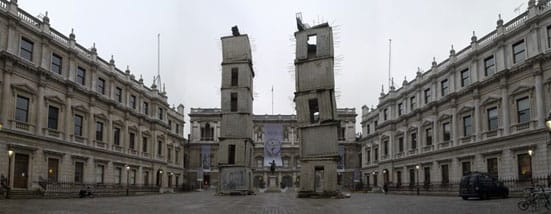26th January 2007 — 17th March 2007
In
the Royal Academy courtyard, where the fountains usually gurgle,
stand two monumental towers. At first glance, these five- and
six-storey structures seem perilously assembled, the bars of
their reinforced concrete jutting out like impromptu scaffolding.
Propped up by lead books, the individual storeys sit at uncertain
angles, giving the overall effect of two tipsy sentinels vainly
defending the RA. At the same time, the rudimentary construction
and roughhewn arches of the towers offer a formal parody of
the pristine neo-classicism that distinguishes the surrounding
architecture of Burlington House.
Entitled 'Jericho', the towers
were transported from Anselm Kiefer's rambling studio in Barjac,
Provence, where about 45 other totemic structures punctuate
the landscape. In rural Barjac, their primordial quality is
foregrounded; the towers are like ancient tenements extending
from the earth up into the heavens. In a metropolitan context,
paired as they are outside the RA, the 'twin towers' assume
more sinister, even apocalyptic associations, suggesting the
hubris and precariousness of great civilisations that have
fallen or been humbled, whether past (Jericho) or present (New
York).
Anselm Kiefer's latest exhibition for White Cube, 'Aperiatur
Terra' ('let the earth be opened'), continues down the road
at Jay Jopling's new space in Mason's Yard. Unlike Kiefer's
previous work which has frequently wrestled with the horrific
legacy of the Third Reich and the post-war Teutonic psyche,
this show takes as its departure point the occasion of Palm
Sunday: the moment when Christ entered Jerusalem prior to his
arrest, Passion, death and resurrection.
In fitting with the
Christian myth, the withered fronds from an uprooted palm tree
lead the viewer into an installation in the ground floor gallery.
The palm's trunk spans the length of the room, traversing a
patchwork of 18 paintings hung frame-to-frame along a single
wall. All manner of organic matter - grit, sand, seeds, straw
- has been incorporated into the paintings' highly worked surfaces:
some are blackened with char, some turned a rich earthy red
by cracked clay, and others are decorated with twigs and bulbs
bleached white in plaster.
Kiefer's work has always been richly
allusive, freely referencing a variety of complex and often
esoteric sources from theology, mythology, alchemy, folklore
and mysticism. Scrawled in chalk or charcoal on the paintings
and walls alike are quotations from the Old Testament, Latin
phrases and dedications to the French writer Victor Hugo. Always
selected with a regard for their historical significance, Kiefer's
treatment of these sources lends the works philosophical and
metaphysical resonances, encouraging manifold possibilities
for interpretation.
But it is the three panoramic paintings
in the lower gallery that are the triumph of this new body
of work. Essentially similar in composition - they depict a
vast and largely devastated landscape strewn with poppies -
their dramatic differences in tone are conveyed through Kiefer's
masterful manipulation of a thick, crumbly impasto technique.
What could have become a sort of formlessness (of a neo-expressionist
bent harking back to the all-over painting of Jackson Pollock)
is anchored structurally by the high horizon line and strong
vanishing point, from which furrows stream out rhythmically
across the land. The bright, pastel poppies in turn provide
an effective foil to this structure, dispersed randomly over
the landscape and creating an unsettling tension between impressions
of order and chaos.
Kiefer has on occasion been accused of
stylistic bombast and an overly ponderous historicising, and
it is true that his painting, especially when laden with obscure
literary and religious references, can veer towards the turgid
or overblown. But at his best, as he is here, the full magnitude
of human experience finds its most monumental, rich and poetic
expression.
NM
White Cube - Mason's Yard
25-26 Mason's Yard
London SW1Y 6B
http://www.whitecube.com
Open
Tuesday-Saturday, 10am-6pm

Anselm Kiefer
Jericho
Installation Royal Academy of Arts, London,
2007
2007
Reinforced concrete and lead
689 x 177 3/16 x 177 3/16
in. (1750 x 450 x 450 cm) and 590 9/16 x 196
7/8 x 189 in. (1500
x 500 x 480 cm)
(c) the artist
Photo: Todd-White Art Photography
Courtesy Jay Jopling/ White Cube (London)